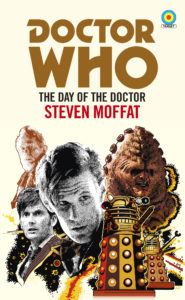„The Day of the Doctor“
Doctor Who – The Day of the Doctor
Erstveröffentlichung: 05. April 2018
Format: Taschenbuch
Seiten: 240
Autor: Steven Moffat
ISBN-13: 978-1-78594-329-4
Die Romanversion von „The Day of the Doctor“ gehört zu einer neuen Reihe von Target Books, die im April 2018 erstmals in Großbritannien veröffentlicht wurden. Autor dieser Novelisation ist der ehemalige Showrunner Steven Moffat, der auch bereits das Drehbuch zum 50-jährigen Doctor Who Jubiläum geschrieben hatte, in dem der Doktor die Chance erhält, den Time War doch noch auf andere Weise, als mit der Zerstörung von Gallifrey, zu beenden.
REZENSION
Im Kern bleibt die Geschichte der TV-Version treu, dennoch gibt es viele kleine, feine Änderungen, die das Lesen des Romans zu einem besonderen Erlebnis machen.
Zum einen gibt es einen übergeordneten Erzähler, der vor und nach jedem Kapitel Erklärungen zu den Ereignissen abgibt, wobei seine Identität erst zum Ende des Buches enthüllt wird. Die Story beginnt außerdem bei Kapitel 8, gefolgt von den Kapiteln 11, 1, 10 und 12. Anschließend kommen Kapitel 2 bis 7 in numerischer Reihenfolge, bevor das Buch mit Kapitel 13 endet. Kapitel 9 existiert in der Inhaltsübersicht nicht, da es sich laut des Erzählers um das gefährlichste des Buches handelt. Was es genau damit auf sich hat, wird im Laufe der Geschichte aufgelöst. Die Kapitel selbst nennt der Erzähler „Doctor Papers“, die, mit wenigen Ausnahmen, aus der Sicht des Doktors geschildert werden:
[…] We’re going to start with Chapter Eight. Bit unusual, I realise, but this being the story of the Time War, there really is no correct order in which to tell it […] [Almost all the Doctor Papers are written by the Doctor himself, at least where we can be certain of authorship. Chapter Nine, The Truth of the Doctor, is the only one where the provenance is uncertain (for reasons that will be evident when we get to it) […] it is the most dangerous Chapter in this book (it’s not even listed on the contents page for that reason) and a proper briefing before reading will be required […
Kapitel 8 startet nach der Einleitung des Erzählers mit “The Night of the Doctor”, einem Prequel der am 14. November 2013 kurz vor der Jubiläumsfolge ausgestrahlt wurde und die Regeneration des 8. Doktors in den Kriegsdoktor zeigt. In der Geschichte versucht der Doktor einer Frau namens Cass zu helfen, die mit ihrem Raumschiff abstürzt. Sie will von ihm allerdings nicht gerettet werden, da sie die Time Lords ebenso wie die Daleks für den zu dieser Zeit herrschenden Time War verantwortlich macht:
She watched him [the Doctor] through the plexi-panel, buzzing away with his silver rod. The door was shuddering, but it didn’t open. […] ‘It’s dead locked. Don’t even try!’ ‘Just open it. Please, I only want to help […] I’m not leaving this ship without you.’ […] Cass Fermazzi smiled and felt the last moment of joy she would ever feel, as she said: ‘Then you’re going to die right here’ […] ‘Cass!’ he was shouting. ‘Cass!’ Yeah, she thought, smiling into this silly, anguished face – say my name. Say my name, Time Lord, and die. Which is exactly what the Doctor did, though not for the last time that day.
Anschließend geht es, nach einem kurzen Resümee durch den Erzähler, mit dem 11. Kapitel weiter. Die dort geschilderten Ereignisse geben den Beginn der Handlung der TV-Version wieder. In der Romanfassung kann der Leser allerdings bereits bevor der Doktor und Clara mit der TARDIS von U.N.I.T. per Hubschrauber „abgeholt“ werden an seinen Gedanken teilhaben und erfährt so, dass ihn die Inkarnation des Kriegsdoktors innerlich schon eine ganze Weile verfolgt hatte:
The Doctor was young – which, he reflected, was a rare pleasure at his time of life. That morning in the TARDIS, over tea and jammy dodgers, he found himself remembering his first proper inspection of the face he was wearing now […] There was a lot of hair now, he noticed. Not ginger, sadly – dark brown […] He did a quick series of calculations in the dust on the floor, and realised this was his eleventh face. ‘No, it isn’t,’ breathed a voice in his ear. His hand froze in the dust. Suddenly his hearts seemed very loud in the silence of the cloisters. ‘Would you deny me?’ whispered the voice. The Doctor took a deep, careful breath, and fought the voice away. Regeneration angst, that was all. ‘Eleventh,’ he said, aloud and firmly.
Als Leser bekommt man allerdings auch Einblicke in die Gedanken anderer Charaktere. Besonders beeindruckt hat mich dabei zum Beispiel, was Kate Lethbridge-Steward denkt, als der Doktor Clara zu ihrer Überraschung verkündet, dass er für U.N.I.T. arbeitet:
It took an effort, but Kate managed not to slap him [the Doctor. Had he really never mentioned any of it? Clara was obviously, at the very least, his friend. Had he never told her he’d spent years, trapped on Earth, in her father’s protection, working with him? They’d stood guard on a world together, they’d been friends. Best friends, she’d thought. She fought down the memory of the dying old soldier in the hospice. Maybe tomorrow.
Neben Gedanken, die neue Informationen in die Geschichte von “The Day of the Doctor” bringen, hat Steven Moffat auch Zusatzszenen in die Romanfassung geschrieben. Im Gegensatz zur TV-Version trifft sich der 10. Doktor so bei seiner Suche nach den Zygons vorab mit River, die ihn daraufhin ins elisabethanische England schickt:
The note she’d [River] left on the TARDIS console directed him to England 1562 and the Royal Court. Zygons always made a beeline for the nearest power structure, she explained, as it was where their shape-shifting abilities had the most immediate advantage. She recommended he infiltrate the court […] and try to work out if anyone had been replaced by a Zygon.
Das erste Aufeinandertreffen des 10. und 11. Doktors sowie ihre anschließende Begegnung mit dem Kriegsdoktor ist sehr gut umgesetzt worden. Durch die Gedankengänge des Time Lords werden diese Szenen noch einmal in einem anderen, äußerst amüsanten Blickwinkel dargestellt:
‘Doctor, who is this man, and what is he doing here?’ […] ‘Just what I was wondering,’ said a man’s voice he didn’t recognise at all. He made an effort to focus. Four Queen Elizabeths stood staring at him. He shook his head, cleared it, and noticed with relief that there were only two. Two? When had there been two? He thought hazily of that birthday when River had cloned herself, then remembered just in time to delete that incident from any written account of his adventures. Also staring at him, he noticed, was a pair of Converse […] ‘You’re not …’ said the Doctor, as if finally understanding who this new arrival was. ‘You can’t be …’ The eyes now looked pained, as they flashed to the Doctor’s bow tie. The Doctor returned the pained look with a smile. You’ll get there, mate, he thought, bow ties are cool […
‘Goodness me,’ I said, giving them my warmest smile. ‘They get younger all the time! Well if you could just point me in the general direction of the Doctor …’ They looked at me, defiant. They each held a magic wand in their hand and now proffered them for my inspection […] As they awaited some […] reaction, I started to notice a hint of presumption in their eyes, which I found intensely irritating, but given their youth, I resisted an impulse to give them a very similar look back. Then, as I turned my attention back to their magic wands, I noticed something. They weren’t magic wands at all! In fact, I was looking at a pair of sonic screwdrivers. The implications of that took a few seconds to unravel in my brain. It is fair to say that in those seconds, for the first time in a very long and often difficult life, I understood why people carried hip flasks.
In der Romanfassung sind die Verhaftung sowie der Aufenthalt im Verließ des Tower of London ebenfalls sehr gut gelungen, denn diese Szenen werden nacheinander sowohl aus der Sicht des Kriegsdoktors, als auch des 10. und 11. Doktors erzählt:
The dungeon was dark and square and cold, and has stayed in my memory, like a trap […] from the moment I arrived there, I knew I was destined to return. My future stood in front of me, twice over. Even if, somehow, I managed to escape, if I found my way to the TARDIS and tore across the galaxies, if I ran to the limits of the universe and hid in the darkest void, in time my path would take me back to this spot […] I knew this place would be my prison, not just today, but in time, and time again […] I made that journey from Richmond to the Tower three times or rather I made it once, and saw it through three different pairs of eyes.
Der Leser erfährt dadurch unter anderem sehr detailliert, wie jeder der drei die Frage sowie die Antwort nach der Zahl der Kinder auf Gallifrey am letzten Tag des Time Wars empfindet. Im Gegensatz zur TV-Version gibt es im Laufe des Buches auch eine Erklärung dafür, weshalb der 11. Doktor diese Zahl vergaß und wie ihm das überhaupt gelingen konnte. Darüber hinaus hat er in der Romanfassung einiges für sein Vergessen einzustecken:
A hand reached in front of me, grabbed hold of my shirt, and yanked me round […] ‘2.47 billion children!’ He [the Tenth Doctor] was screaming now, right into my face. ‘Of course I counted them. How could I not count them?? Of course I did! And you forgot??’ he roared into my face. ‘How do you forget that??’ And then I have a feeling he might have thrown me across the room. Anyway, a wall got suddenly in my way, and at the same time all the lights started to flicker. As I slid to the floor, it occurred to me that there weren’t any lights in the dungeon.
Ein weiteres Highlight dieses Romans ist das 6. Kapitel. Dort steht Petronella Osgood im Vordergrund, die einen Brief an ihre Zygon-Kopie verfasst, durch den deutlich wird, warum es anschließend zwei Osgood gab:
Dearest Petronella, Hello you. Or Hello me. It’s Petronella here. By the time you read this, I think, you’ll be about to abandon your human form – but I wonder if you would mind waiting just a little? Could you read this letter, while you’re still me? There’s something I want to explain.
Unabhängig von der eigentlichen Storyline von “The Day of the Doctor” hat Steven Moffat den Doktor zudem zum Fan der 60er Jahre Filme „Dr. Who and the Daleks“ sowie „Daleks: Invasion Earth“ gemacht und den Schauspieler Peter Cushing damit offiziell ins Whoniverse eingebunden:
There had been an ugly period when they [the Tenth & Eleventh Doctor] discovered a VHS tape of the movie ‘Daleks: Invasion Earth’ and had insisted on watching it. They nearly derailed the negotiations [with the Zygons] by shouting, cheering and joining in, and then had spent the next hour calling each other Dr. Who and talking like Peter Cushing.
Im 7. Kapitel findet die eigentliche Rettung von Gallifrey statt, die in der Romanfassung mit großen Schwierigkeiten für den Planeten behaftet ist, sodass der Doktor in all seinen Inkarnationen gleichzeitig zur Hilfe eilt, um die Menschen zu retten:
It took the better part of a day to translate the world of Gallifrey from one plane of reality to another […] the planet screamed and burned and raged […] everywhere the people ran, they found a police telephone box standing in front of them, opening doors […] I was everywhere I was needed that day, across all my lives, and I believe I never have run so fast.
Zusammengefasst hat mir die Romanfassung von „The Day of the Doctor“ sehr gut gefallen, da der Aufbau, trotz der ungewöhnlichen Handlungsstruktur und vielen Perspektivwechsel, gut durchdacht ist. Allerdings ist es durchaus empfehlenswert, das Buch ein zweites Mal zu lesen, um es voll und ganz genießen zu können. Die zum Teil überraschenden Wendungen und Enthüllungen fand ich ebenso gelungen, wie Steven Moffats Schreibstil, der sich flüssig lesen lässt und mit tollem Humor versehen ist. Was ich ebenfalls sehr gut fand, waren die vielen Erwähnungen früherer Begleiter des Doktors und, dass neben anderen Inkarnationen auch bereits der 13. Doktor in Erscheinung tritt. Dieses Buch ist definitiv eine Bereicherung zur bereits großartigen TV-Version.
Alle Bücher der aktuellen „Target Collection“ | HIER BEI AMAZON:
[amazon template=iframe image&asin=178594326X,1785943286,1785943294,1785943308,1785943278]













Ist ein Hörbuch in Planung?